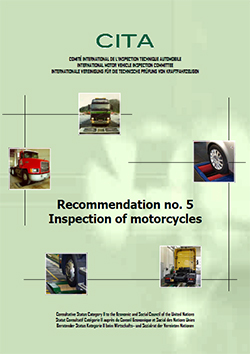 On 13th July, 2012 the European Commission published a proposal for mandatory Road Worthiness Testing (RWT). Included within that proposal the Commission called for European wide roadworthiness testing for motorcycles and scooters. There are eleven countries that do not include these vehicles within their testing regimes, in some other countries, scooters are not included and in others the Commission has called for more frequent testing.
On 13th July, 2012 the European Commission published a proposal for mandatory Road Worthiness Testing (RWT). Included within that proposal the Commission called for European wide roadworthiness testing for motorcycles and scooters. There are eleven countries that do not include these vehicles within their testing regimes, in some other countries, scooters are not included and in others the Commission has called for more frequent testing.
In the United Kingdom the frequency is the same as for cars – 3-1-1-1 which means that the first test takes place when the vehicle is 4 years old and followed by an annual inspection. Along with Austria, Luxembourg and Slovenia, the Commission is not requesting any change in these countries.
However in other countries, the proposal suggests testing motorcycles and scooter with the frequency of 4-2-1, which would require the first test when the vehicle is 5 years old, followed by a test after two years, then every subsequent year.
Within the proposal, the Commission has set out what actually refers to testing, for example, in Annex IV of the proposal there is a list of equipment required for the purpose of performing a roadworthiness test, which any mechanic can look at and consider what they would need to perform. These are listed as
- A sound level meter
- A 4-gas analyser
- One headlamp aiming device, that allows the test of the setting of the headlight
- A device for measuring the tread depth of tyres;
- A device for checking the brake fluid,
- An OBD scan tool.
From these tests, it would appear that the checks are limited to vehicle identification, the chassis, steering, lighting, tyres, possibly electronics to identify emissions, brakes, however, with regards to brakes or rather brake-fluid content for example, the recommendations of CITA’s document, Regulation 5 highlight that the examination of the motorcycle should take place without dismantling the brakes.
The proposal also lays down new requirements on several issues related to the standard and quality of testing, namely test equipment, skills and training of testing personnel and supervision of the testing system – which may vary substantially across Europe and which – covers all vehicles – not just motorcycles and scooters.
We know from previous experience that what is set out in a proposal is not cast in stone and inevitably requires discussion – amongst experts – in order to come up with a sensible, workable document that, in this case, testing stations throughout Europe can work with.
As ‘Matters Of Testing’ pointed out, “New EU laws take a while to put into place. While this process is under way you can be sure that we at VOSA and our colleagues at the Department for Transport will be contributing to the debate about bike testing across Europe.”
The views highlighted here by VOSA suggest that it is unlikely that there will be any Super MoT/German TüV system of RWT with an amalgamation of Type Approval Testing Standards.
While we appreciate that crying wolf – or in this case – “Super MoT” – is appealing, the debate goes on.
As we have commented in other occasions, we all need to take a deep breath and sit round the table with these people to start the dialogue.
Read the full article on Right To Ride EU – Leave Comments – Click Here
.


